Development of a Unified Geotechnical Database and Data Processing on the Example of Nur-Sultan City
Abstract
:1. Introduction
2. Development of a Geoinformation Database
- (1)
- clarification of the physical-geographical, geological, geomorphological and lithological conditions;
- (2)
- qualitative and quantitative characteristics of the structure, composition, state and properties of genetic, age and petrographic types of soils and mapping the spatial variability of their indicators;
- (3)
- identification of soil layering conditions and their location;
- (4)
- establishing the nature and intensity of development of modern geological and engineering-geological processes and phenomena.
- (1)
- General management function (Host DB).
- (2)
- Input control data function (Local DB).
- (3)
- Function of data extraction and processing (AP).
- (4)
- Data augmentation function (Layer DB).
- −
- Fixed datasets that form a local program database.
- −
- Initial data prepared directly by the user and entered during program execution.
- (a)
- The survey area was determined and a map of the survey area is created in CAD program, i.e., AutoCAD.
- (b)
- The location of each borehole was indicated and labeled on the survey area map.
- (c)
- The exact X and Y coordinates were determined for each borehole.
- (d)
- A set of data was collected in the Excel table to log the information about each borehole and the location of Static pile load tests which were reflected in the geological-lithological columns:
- −
- each borehole was assigned an identification code of the borehole and the coordinates were entered according to X and Y, the level of the ground surface H, the depth of borehole and the level of groundwater,
- −
- the same way data were applied for each point of Static pile load test with a link to a nearby borehole location,
- −
- for each associated borehole the geological-lithological columns were inserted, which include the depth of the deposit, the age and name of the soil that ensures the stratigraphy subsequent location of the layers, as well as the coded state or if (if loose soil then the code is equal to zero, if half-rock or rock is 1,2,3,4 depends to the type of the rock soils),
- −
- the data of previously performed Static pile load tests were recorded according to their passport,
- −
- after this the processing of all data was performed and their reliability were verified.
3. Subdivision of the City Territory into Conditionally Homogeneous Geological Zones
- physical characteristics: particle size distribution, specific and volumetric weight, volumetric weight of the skeleton, moisture, plasticity and consistency, porosity and coefficient of porosity, water permeability, and other indicators.
- mechanical characteristics, which allow assessing the behavior of soils under the influence of external forces: deformation modulus E, which is associated with compressibility of the soils and their bearing capacity.
4. Construction of a Special Geotechnical Zoning Map in Order to Optimize the Length of the Piles
5. Discussion
6. Conclusions
- (1)
- The algorithm for collecting geoinformation data to create a single data set is presented.
- (2)
- The program “Geoinformation Database “ was developed for
- −
- creating engineering and geological maps of construction sites,
- −
- study and analyze the results of engineering and geological surveys;
- −
- identify the main engineering and geological elements;
- −
- to build special geotechnical maps of Quaternary deposits and bedrocks for the city.
- (3)
- The territory of the city of Nur-Sultan was regrouped into eight zones instead of the previous six, based on the geological origin and stratigraphy interposition of the six main engineering-geological elements (EGE).
- (4)
- The analysis of physical and mechanical properties of the soil located in the territory of the city of Nur-Sultan signified that the increased liquid and plastic limits are replicated by higher values of elasticity modulus E, and hence better strength characteristics of a particular soil layer and vice versa, while the moisture content and soil density did not show any obvious pattern and requires additional verification on the construction site.
- (5)
- The scatter of the soils properties observed during the research and reflected in the scatter plot graph corresponds to the patterns established by the methods of mathematical statistics.
- (6)
- The zoning map for optimization of pile lengths was designed depending on the type of underlying soil, i.e., zoning and previously performed Static pile load test results recorded in the geotechnical database.
Author Contributions
Funding
Data Availability Statement
Acknowledgments
Conflicts of Interest
References
- Smith, A.; Ellison, R. Applied geological maps for planning and development: A review of examples from England and Wales, 1983 to 1996. Q. J. Eng. Geol. 1999, 32, S1–S44. [Google Scholar] [CrossRef]
- Soil Survey Division Staff, Soil Survey Manual; Soil Conservation Service U.S. Department of Agriculture Handbook; USDA: Washigton, DC, USA, 1993; p. 18.
- Guenther, O.; Buchmann, A. Research Issues in Spatial Databases; Directions for Future Database Research & Development, Ed.; ACM SIGMOD Record: Nashville, TN, USA, 1990; Volume 19, pp. 61–68. [Google Scholar] [CrossRef]
- Laurini, T.; Thompson, D. Fundamentals of Spatial Information Systems; Academic Press: London, UK, 1992; 680p. [Google Scholar]
- Penninga, F.; van Oosterom, P.J.M. A simplicial complex-based DBMS approach to 3D topographic data modelling. Int. J. Geogr. Inf. Sci. 2008, 22, 751–779. [Google Scholar] [CrossRef]
- Minasny, B.; McBratney, A.B. Digital soil mapping: A brief history and some lessons. Geoderma 2016, 264, 301–311. [Google Scholar] [CrossRef]
- Harris, C.; Arenson, L.U.; Christiansen, H.H.; Etzelmuller, B.; Frauenfelder, R.; Gruber, S.; Haeberli, W.; Hauck, C.; Hoelzle, M.; Humlum, O.; et al. Permafrost and climate in Europe: Monitoring and modelling thermal, geomorphological and geotechnical responses. Earth-Sci. Rev. 2009, 92, 117–171. [Google Scholar] [CrossRef] [Green Version]
- Werner-Allen, G.; Johnson, J.; Ruiz, M.; Lees, J.; Welsh, M. Monitoring volcanic eruptions with a wireless sensor network. In Proceedings of the Second European Workshop on Wireless Sensor Networks (EWSN); IEEE: Istanbul, Turkey, 2005; p. 13. [Google Scholar]
- Meersmans, J.; Martin, M.P.; Lacarce, E.; De Baets, S.; Jolivet, C.; Boulonne, L.; Lehmann, S.; Saby, N.P.A.; Bispo, A.; Arrouays, D. A high resolution map of French soil organic carbon. Agron. Sustain. 2012, 32, 841–851. [Google Scholar] [CrossRef]
- Smith, K. Environmental Hazards: Assessing Risk and Reducing Disaster, 4th ed.; Routledge: New York, NY, USA, 2004; 383p. [Google Scholar]
- Aldefae, A.H.; Mohammed, J.; Saleem, H.D. Digital maps of mechanical geotechnical parameters using GIS. Cogent Eng. 2020, 7, 1779563. [Google Scholar] [CrossRef]
- Arshid, M.U.; Kamal, M.A. Regional Geotechnical Mapping Employing Kriging on Electronic Geodatabase. Appl. Sci. 2020, 10, 7652. [Google Scholar] [CrossRef]
- Popov, I.V. Engineering Geology; Textbook; Gosgeolizdat: Moscow, Russia, 1951; 444p. [Google Scholar]
- Popov, I.V. Engineering Geology. USSR. Part V. Kazakhstan. Average Asia; State University Publishing House: Moscow, Russia, 1974; 431p. [Google Scholar]
- Kotlov, F.V.; Snobkova, A.I. Production of Complex Engineering-Geological Surveys for Underground Civil and Industrial Construction. Review; Publishing House PNIIIS: Moscow, Russia, 1980; 37p. [Google Scholar]
- Kolomensky, N.V. General Method of Engineering and Geological Research; Nedra: Moscow, Russia, 1968; 344p. [Google Scholar]
- Dmitrovsky, V.I. (Ed.) Engineering Geology of the USSR, Vol. 6. Kazakhstan; Publishing House of Moscow University: Moscow, Russia, 1977; 296p. [Google Scholar]
- Alibekova, N.T.; Zhussupbekov, A.Z. GIS Technology in Engineering and Geological Surveys; Lap Lambert Academic Publishing: Beau Bassin, Mauritius, 2018; 188p. [Google Scholar]
- SNIP RK 2.04-01-2010 Building Climatology; RGP "Kazakh Research and Design Experimental Institute of Earthquake Engineering and Architecture: Almaty, Kazakhstan, 2010.
- In 23 Years, the Population of Nur-Sultan has Almost Tripled. Available online: https://www.inform.kz/ru/za-23-goda-naselenie-nur-sultana-vyroslo-pochti-v-tri-raza_a3665670 (accessed on 24 June 2020).
- Tulebekova, A.S.; Zhusupbekov, A.Z.; Shakhmov, Z.A.; Yenkebayev, S.B. Experience of testing according to international standard ASTM on problematical soil ground of Astana. Bull. L.N. Gumilyov Eurasian Natl. Univ. 2012, 2, 126–131. [Google Scholar]
- Zhussupbekov, A.Z.; Omarov, A.R.; Zhukenova, G.A.; Tanyrbergenova, G.K. Geotechnical Infrastructures of New Capital Astana on Problematical Soil Ground. In Proceedings of the 17th Nordic Geotechnical Meeting, Challenges in Nordic Geotechnic, Reykjavik, Iceland, 25–28 May 2016; pp. 923–930. [Google Scholar]
- Popov, V.N. Geotechnical Problems of Foundation Engineering in Conditions of Activation of Natural and Man-Made Processes and Ways to Solve Them. Ph.D. Thesis, Eurasian National University, Astana, Kazakhstan, 2004; p. 270. [Google Scholar]
- Vershin, V.P. Foundation design—From engineering surveys to scientific and technical support of construction. Secur. Technol. Eng. Syst. 2005, 6, 26–28. [Google Scholar]
- Zhusupbekov, A.; Morev, I.; Iwasaki, Y.; Mimura, M. Geotechnical issues of geodata base of soil ground of new capital Astana. In International Symposium on Advances in Ground Technology and Geo-Information (IS-AGTG); Advan GES in Ground Technology and Geoinformation: Singapore, 2011; pp. 175–181. [Google Scholar]
- Zhussupbekov, A.Z.; Alibekova, N.T.; Akhazhanov, S.B.; Shakirova, N.; Alpyssova, A. Development Geoinformation database for optimization length of driving and boring piles. In Proceedings of the International Conference on GIS and Geoinformation Zoning for Disaster Mitigation (GIZ 2018), Auckland, New Zealand, 15–17 November 2018; pp. 97–99. [Google Scholar]
- Alibekova, N.; Zhussupbekov, A.; Mimura, M.; Akhazhanov, S. Geoinformation Database for Installation of Driving and Boring Piles in Astana /16th Asian Regional Conference on Soil Mechanics and Geotechnical Engineering; Geotechnical Special Publication, ARC 2019: Taipei, Taiwan, 2020. [Google Scholar]
- Mimura, M.; Yamamoto, K. Development of Geoinformatic Databases and their Application to Geotechnical Problems; No 83 Genting Lane, #08-01; Genting Building: Singapore; Research Publishing Services: Singapore, 2012. [Google Scholar]
- Zhussupbekov, A.Z.; Alibekova, N.T.; Akhazhanov, S.B.; Shakirova, N.U.; Alpyssova, A.B. Geotechnical Geo-Information System of Astana. Soil Mech. Found. Eng. 2019, 55, 420–424. [Google Scholar] [CrossRef]
- Official (Ed.) SNIP RK 5.01-03.2002 Pile Foundations; Committee on Construction Affairs of the Ministry of Industry and Trade of the Republic of Kazakhstan: Nur-Sultan, Kazakhstan, 2002; 44p.
- Reddy, N.N.; Chakraborty, P.; Roy, S.; Singh, K.; Minasny, B.; McBratney, A.B.; Biswas, A.; Das, B.S. Legacy data-based national-scale digital mapping of key soil properties in India. Geoderma 2021, 381. [Google Scholar] [CrossRef]
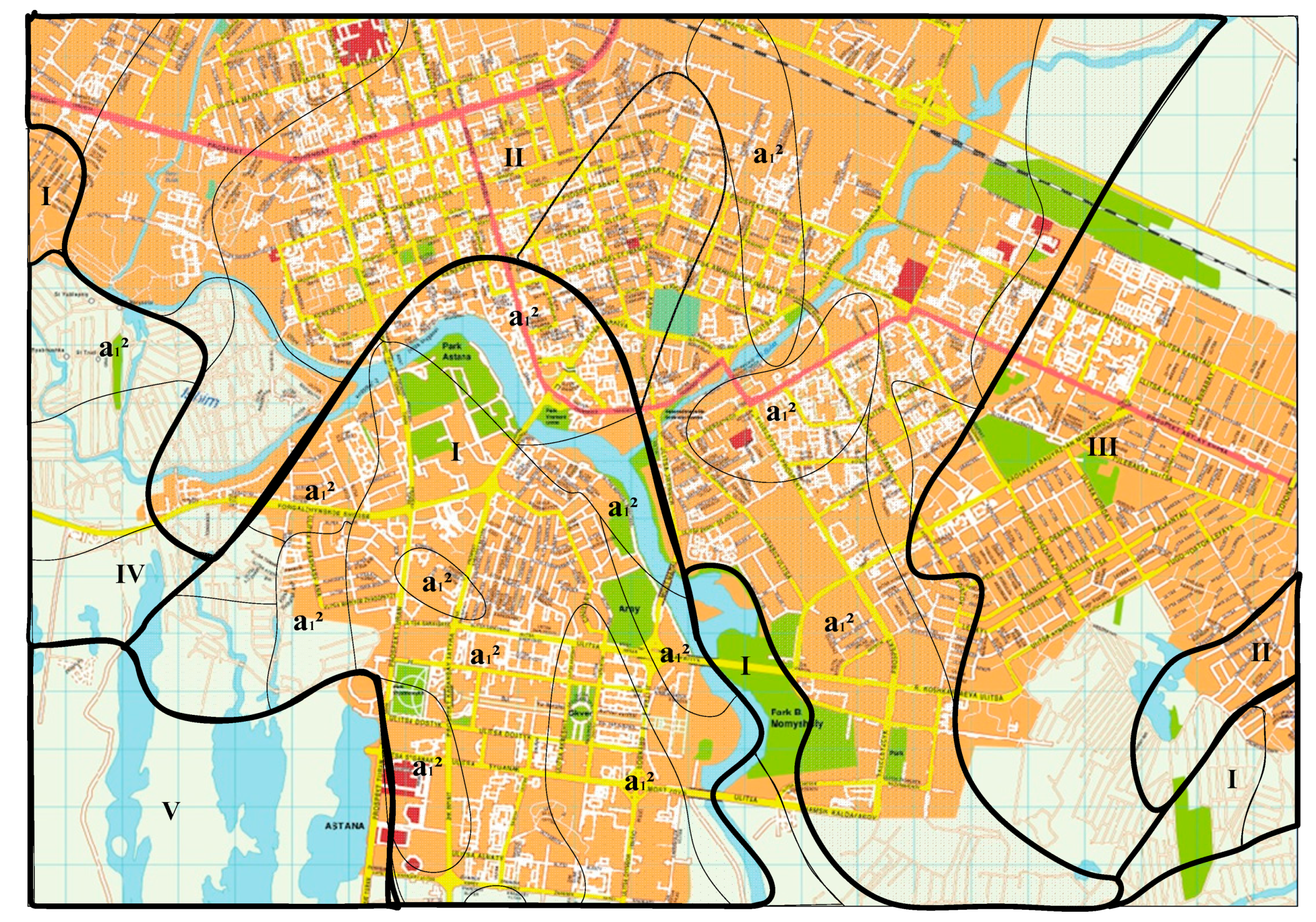
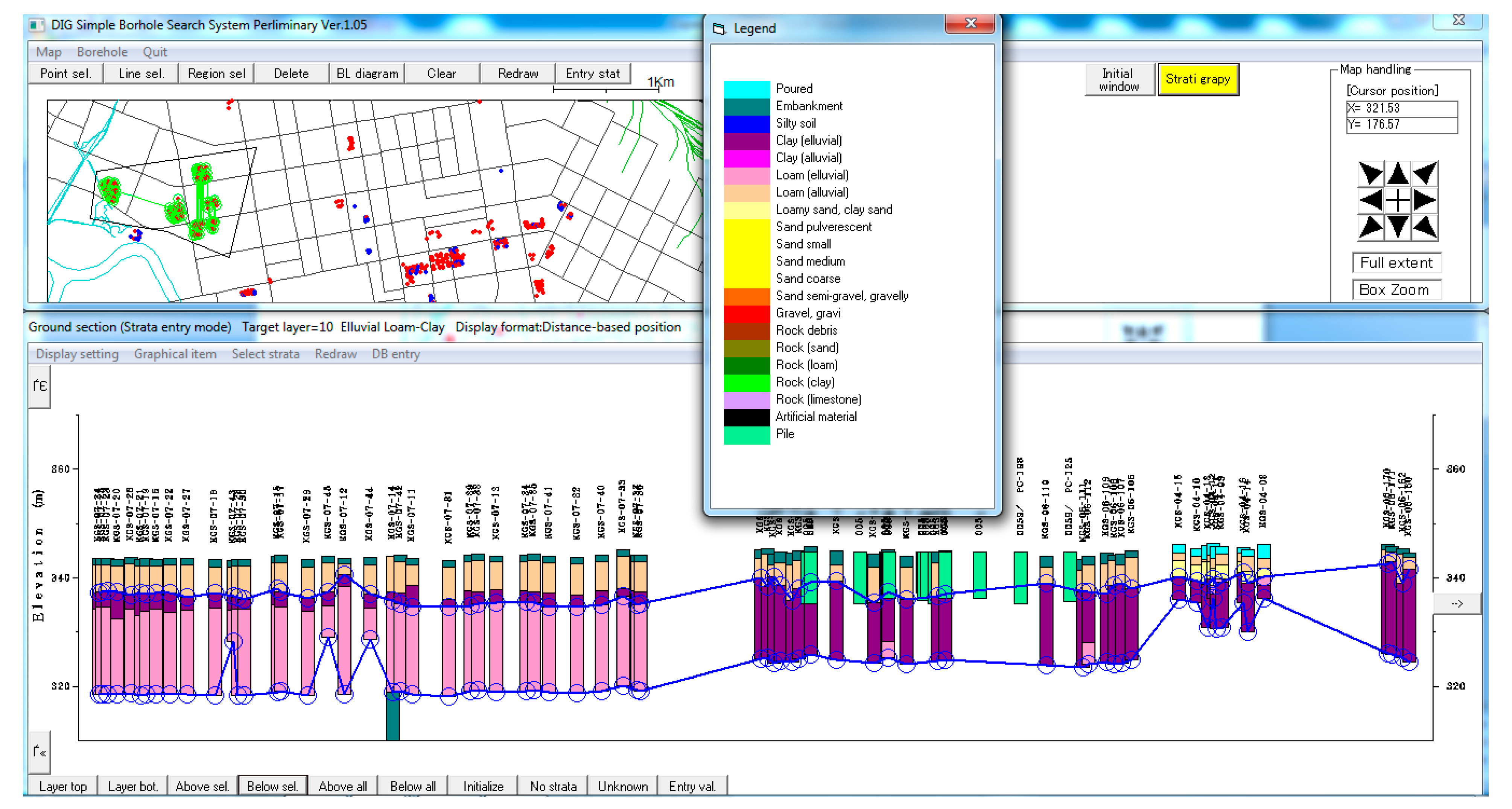
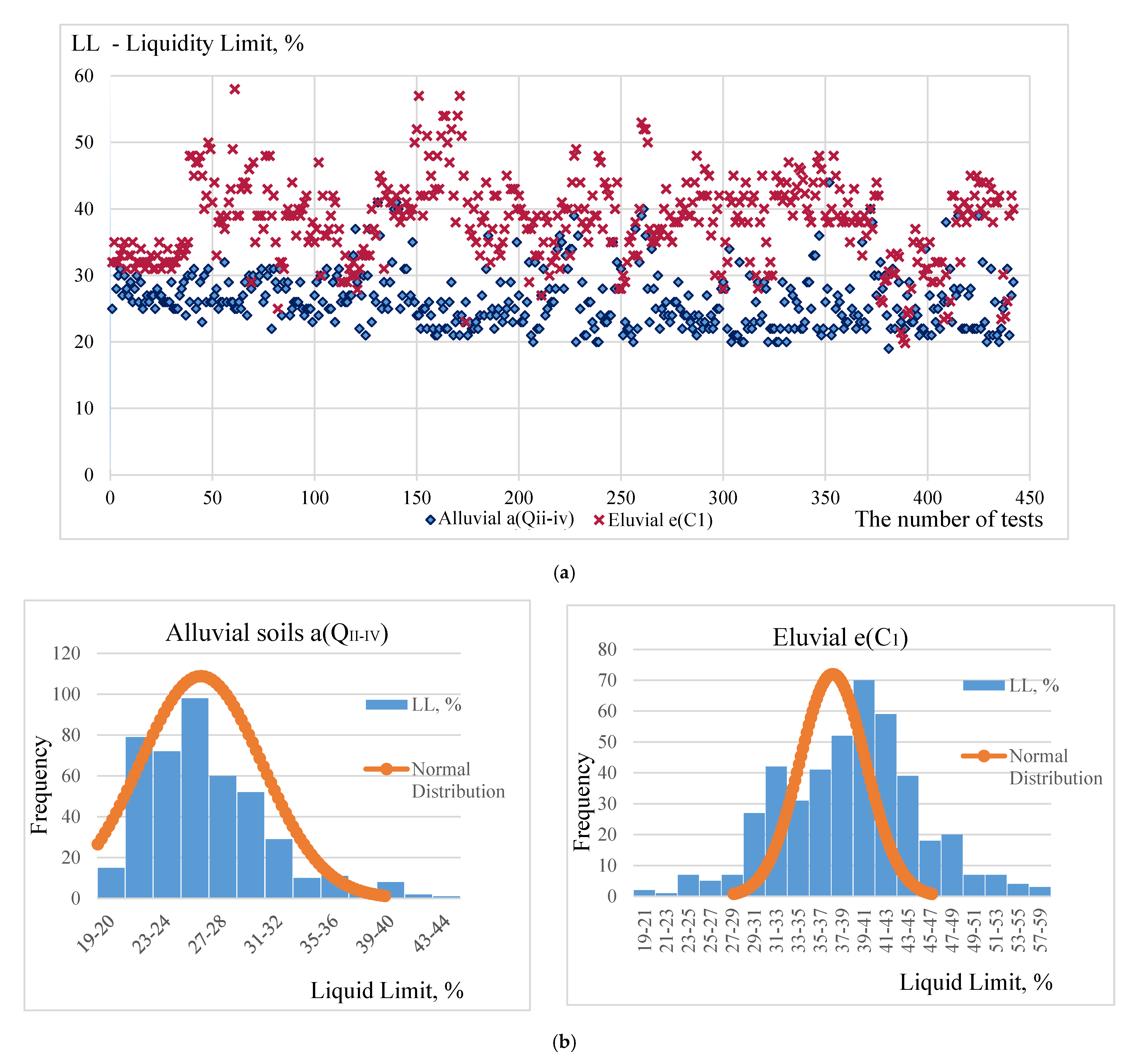
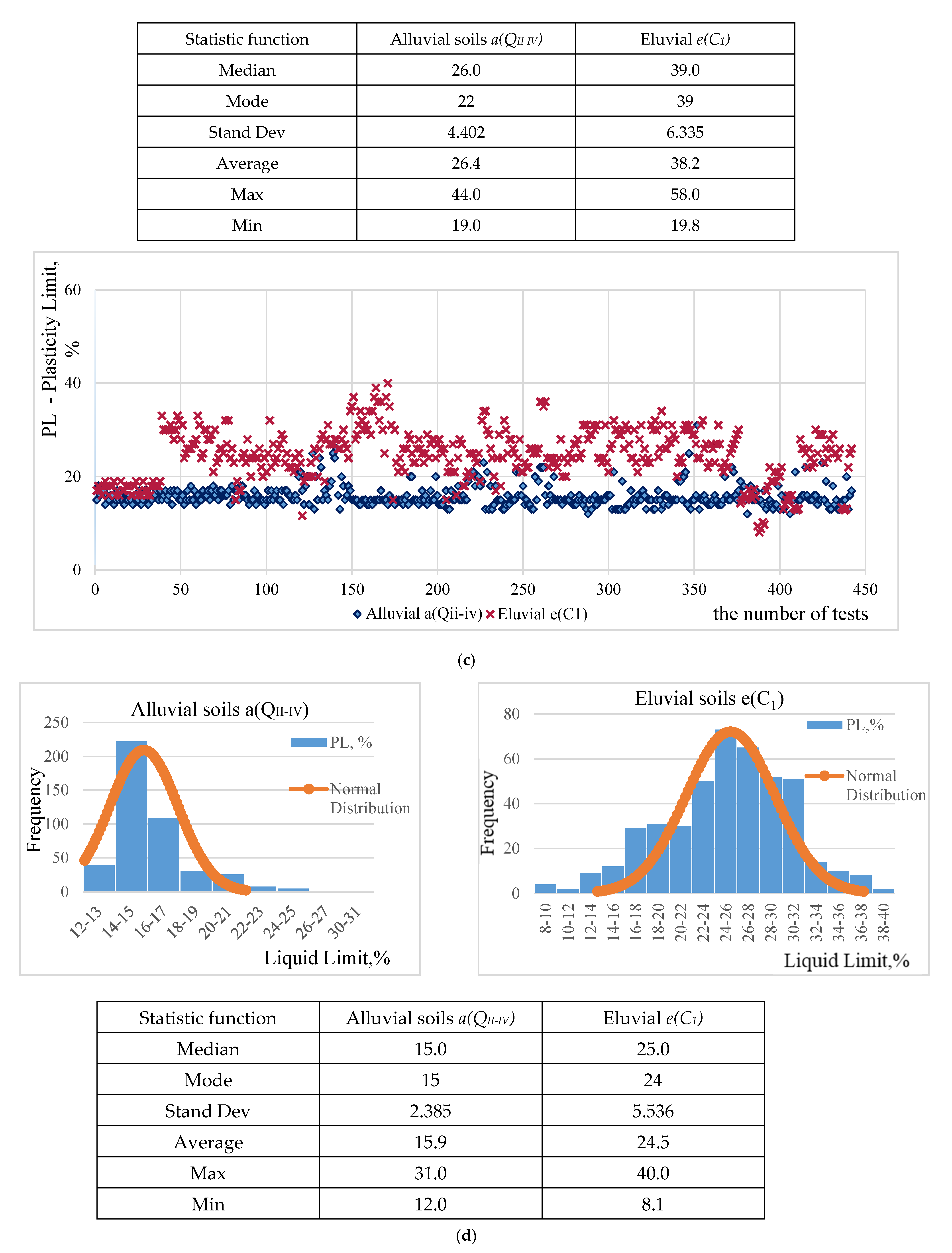

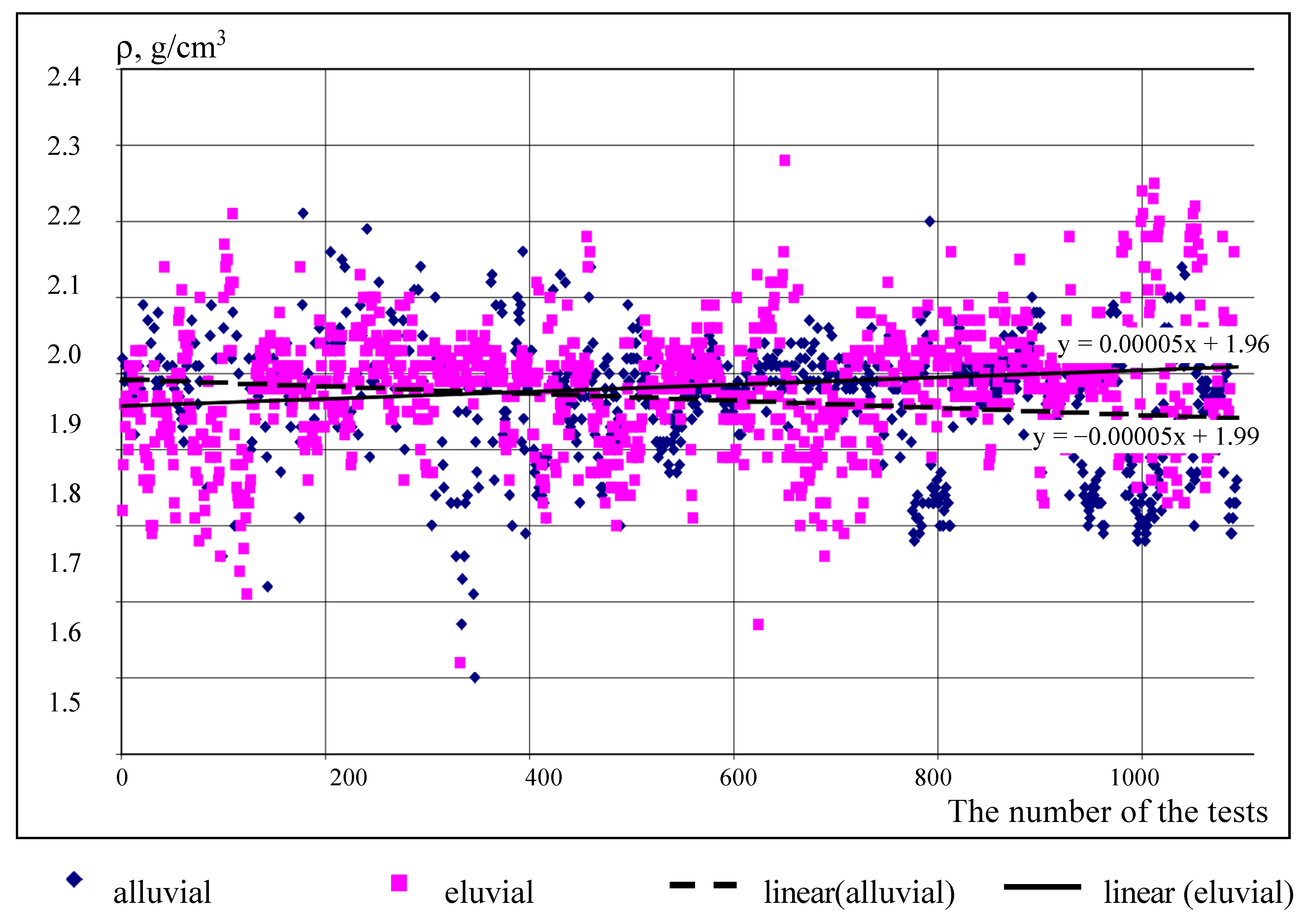

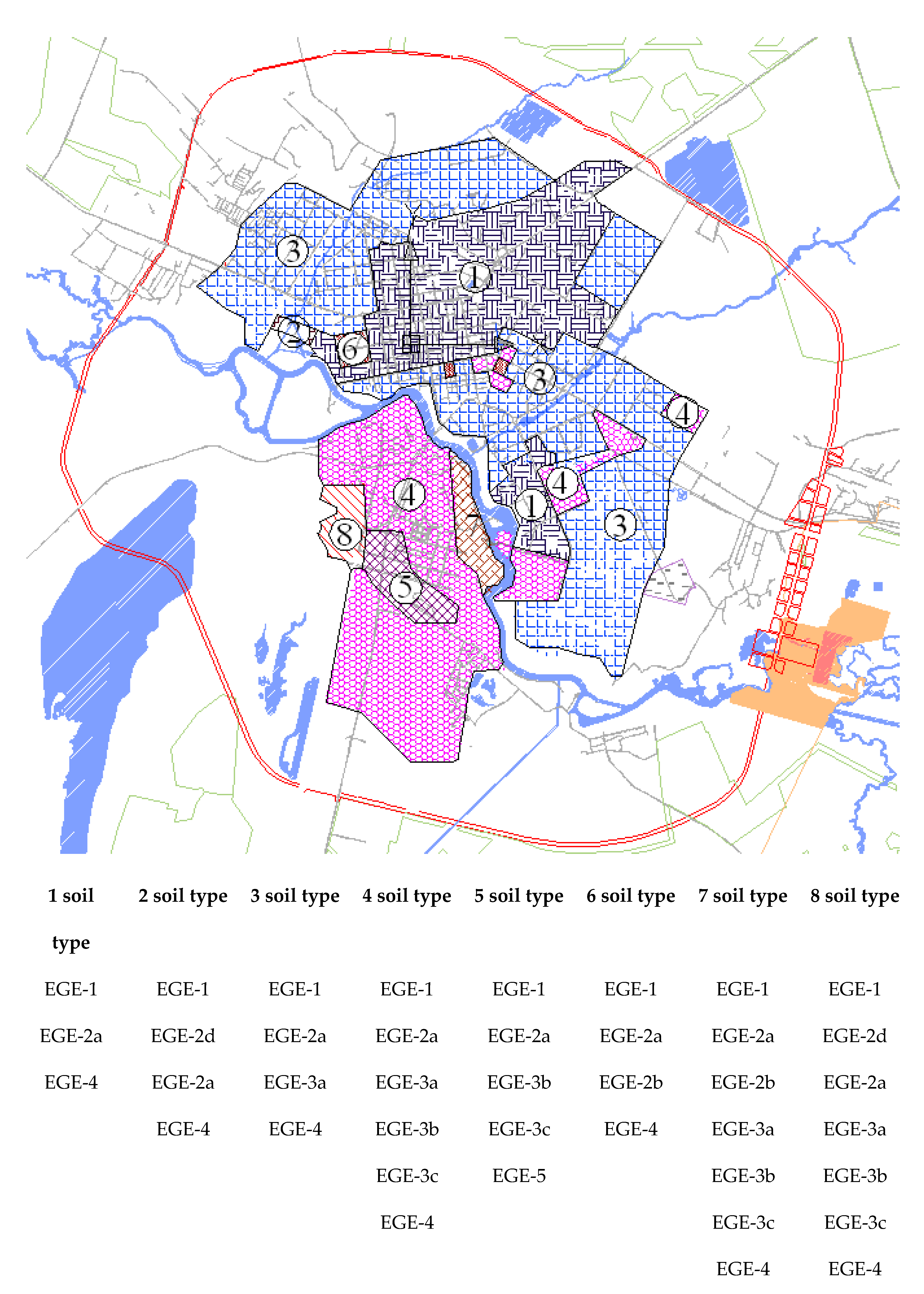
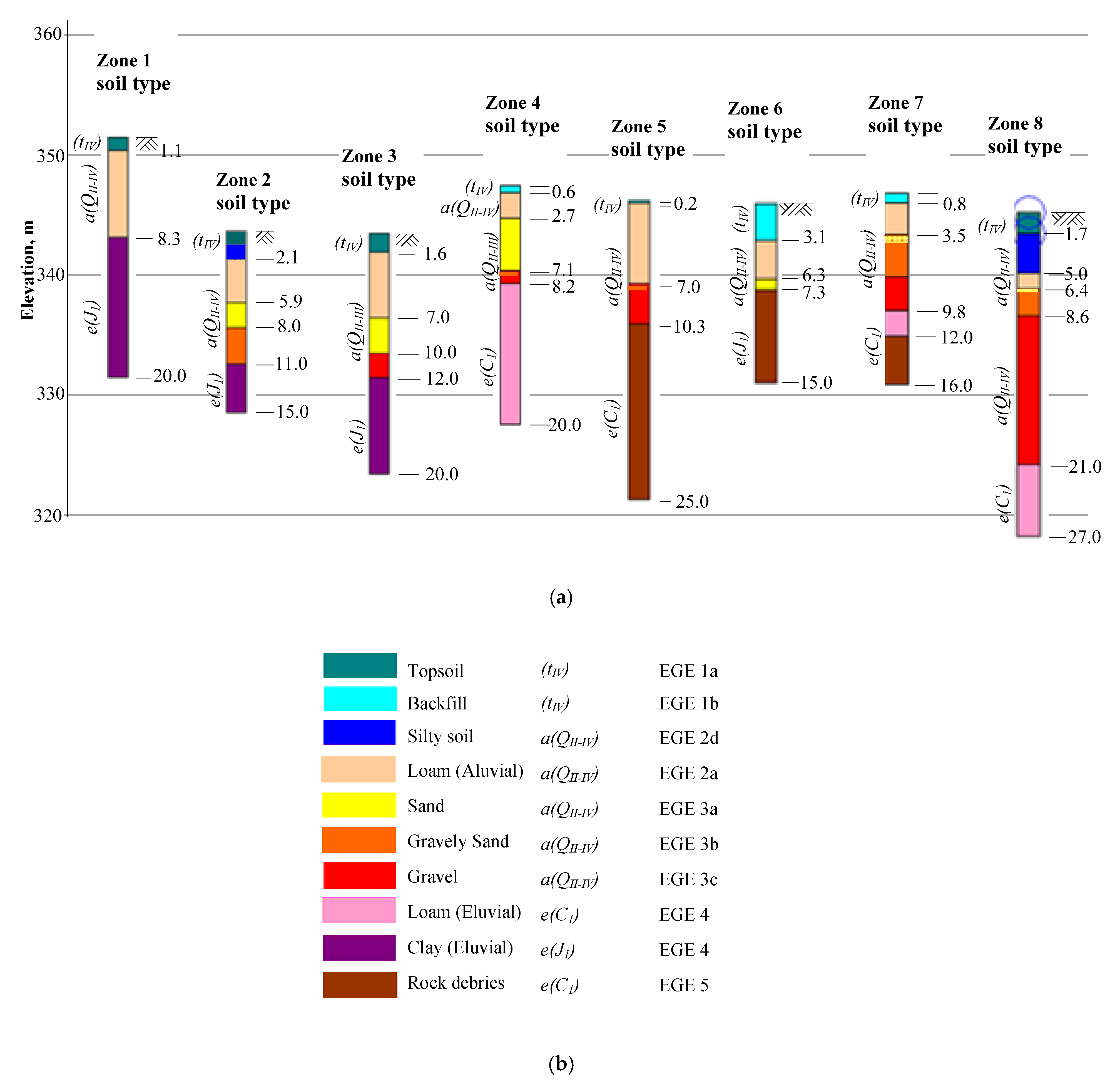
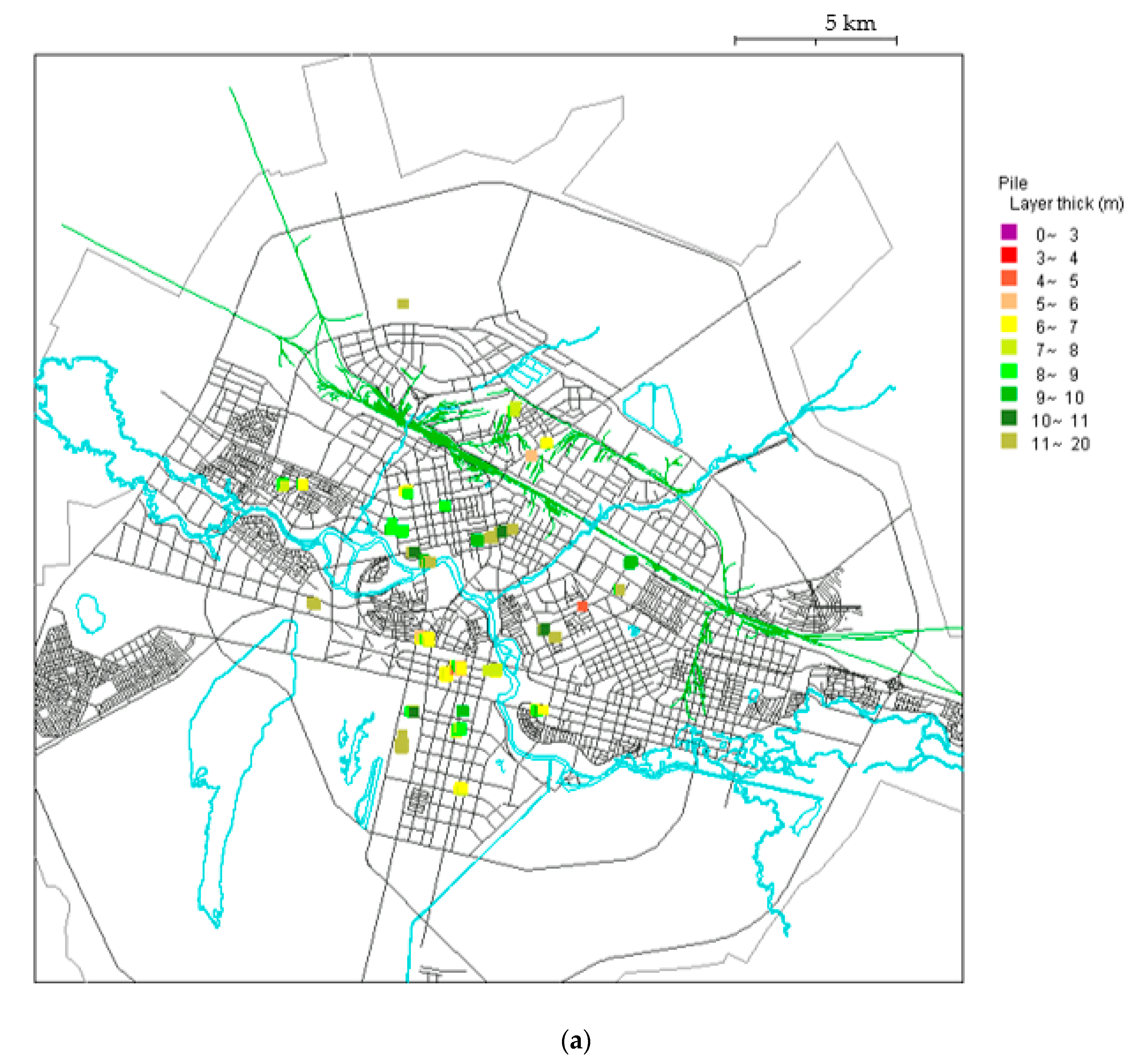

| The Shape of the Terrain | Genetic Type of Terrain | Area | Landmarks | |
|---|---|---|---|---|
| Horizontal | Vertical | |||
| Accumulation | Terrace over the first floodplainvalley-a(QII-III) middle and upper quaternary geological period sands, clayey sands, sandy clays and clays | I | Widely observed on the left and right banks of river Ishim and in direct contact with the riverbed. Its width is up to 1–3 km | The height of the edge of the terrace varies from 1.5 to 4 m above the surface of the valley. The slope of the terrace is often precipitous. |
| Sculptured | The watershed plain is composed of Carboniferous e(C1) and Jurassic e(J1) rocks, with an average of modern quaternary geological period a(QII-IV) with upper layers of sand, clayey sands, sandy clays and clays of different particle sizes over sandy clays and clays | II | Sculptural terrace | The ledge of the plain to the first floodplain terrace from the shallow sand is slightly flat.The slope of the surface is from northeast to southwest. |
| Sculptured | Small hills-Carboniferous e(C1) rocks, covered with a layer of sand, sandstones, loams of various sizes a(QII-III). | III | Located north and northeast of the Ishim River, and in the south-east along the river valley.Its development strip is up to 5 km wide | represented by low hillsand hillocks, their height is 10–20 m above the valley surface. |
| Accumulation | High floodplain valley- reduction of natural outflow of “SaryBulak” and “TuzdyZhyra” streams-layering of sands, clayey sands, sands a(QII-IV). | IV | Observed in small areas on the left and right banks. Its width varies from 100 to 500 m. | The upper surface of the valley is not smooth and consists of many old canals with a depth of 2–2.5 m. |
| Accumulation | Lower floodplain valley-canals, quarries, pits-sands, sedimentary clays a(QII-IV) | V | Observed in the western part of the left bank of the river. | Above the floodplain water rises 0.2–1.0 m |
| Engineering-Geological Element (EGE) | Geological Index (Age) | Average Column of Soils | Limits of Changes in Layer Thickness, m | Elastic Modulus (Young’s Modulus)E, MPa |
|---|---|---|---|---|
| EGE-1 | tIV | EGE-1a | 0.3–1.4 | |
| EGE-2 | a(QII-IV) | EGE-2a | 1.7–4.4 | 4.3 |
| EGE-2b | 0.3–0.7 | 4.3 | ||
| EGE-3 | a(QII-IV) | EGE-3b | 1.3–3.5 | 21.2 |
| EGE-3c | 2.8–5.2 | >30 | ||
| EGE-4 | e(C1) | EGE-4 | 2.2–3.3 | 10.75 |
| EGE-5 | e(C1) | EGE-5 | >4 | >30 |
| EGE-6 | (C1) | EGE-6 | 3.3–23.0 |
| The Name of Indicators | Sandy Clay Loams a(QII-IV) 1 (EGE-2a) | Sandy Clay Loams e(C1) (EGE-4) |
|---|---|---|
| Natural moisture W, % | 19.1 (10.2–27.7) | 24.1 (11.7–37.4) |
| Liquid Limit WL, % | 30.0 (21.0–48.0) | 39.0 (28.0–58.0) |
| Plastic Limit WP, % | 18.0 (14.0–32.0) | 27.0 (20.0–38.0) |
| Plastic index PI, % | 12.0 (7.0–16.0) | 22.0 (8.0–30.0) |
| Liquid index, LI | 0.39 (<0–1.0) | <0 |
| Particle density ρs, г/cm3 | 2.71 (2.67–2.74) | 2.74 (2.71–2.78) |
| Bulk density ρ, г/cm3 | 1.98 (1.84–2.09) | 1.96 (1.90–2.12) |
| Void ratio e | 0.63 (0.50–0.68) | 0.70 (0.59–0.80) |
| Degree of saturation S | 0.74 (0.50–1.11) | 0.96 (0.81–1.08) |
| Cohesion c, kPa | 15 | 27 |
| Angle of internal friction φ, grad | 22 | 29 |
| Elasticity modulus E, MPa | 7 | 10 |
| Soil Type | Pile Depth Variation Within Each Zone, m | Bearing Capacity of the Driven Piles, kN | |||
|---|---|---|---|---|---|
| Based on Test Results(Maximum and Minimum Values), kN | Calculated According to SNIP RK 5.01–03.2002 [28] (Upper and Lower Reading Limits) | ||||
| Under the Lower End of the Pile | Frictional Resistance of the Pile | Total Bearing Capacity | |||
| Zone 1 | 8.5–9.5 | 1026.0–1270.0 | 450.0–977.0 | 0–465.0 | 882.4–1054.2 |
| Zone 2 | 8.5–9.5 | 660.0–846.0 | 360.0–439.5 | 360.0–439.5 | 498.7–710.0 |
| Zone 3 | 7.0–8.5 | 673.0–746.0 | 326.3–873.0 | 121.1–324.4 | 454.1—1197.4 |
| Zone 4 | 6.0–11.50 | 705.0–1192.0 | 369.5–466.2 | 395.5–463.3 | 865.3–1039.2 |
| Zone 5 | 5.7–8.5 | 490.0–975.0 | 434.7–900.0 | 0–129.5 | 434.7–949.8 |
| Zone 6 | 8.5–8.6 | 606.0–938.0 | 362.7–643.5 | 186.5–438.1 | 555.9–898.9 |
| Zone 7 | 7.3–8.0 | 637.0–1020.0 | 875.7–885.5 | 0 | 875.7–885.5 |
| Zone 8 | 10.3–11.5 | 533.0–910.0 | 432.0–460.8 | 0–457.1 | 432.0–944.8 |
Publisher’s Note: MDPI stays neutral with regard to jurisdictional claims in published maps and institutional affiliations. |
© 2020 by the authors. Licensee MDPI, Basel, Switzerland. This article is an open access article distributed under the terms and conditions of the Creative Commons Attribution (CC BY) license (http://creativecommons.org/licenses/by/4.0/).
Share and Cite
Zhussupbekov, A.; Alibekova, N.; Akhazhanov, S.; Sarsembayeva, A. Development of a Unified Geotechnical Database and Data Processing on the Example of Nur-Sultan City. Appl. Sci. 2021, 11, 306. https://doi.org/10.3390/app11010306
Zhussupbekov A, Alibekova N, Akhazhanov S, Sarsembayeva A. Development of a Unified Geotechnical Database and Data Processing on the Example of Nur-Sultan City. Applied Sciences. 2021; 11(1):306. https://doi.org/10.3390/app11010306
Chicago/Turabian StyleZhussupbekov, Askar, Nurgul Alibekova, Sungat Akhazhanov, and Assel Sarsembayeva. 2021. "Development of a Unified Geotechnical Database and Data Processing on the Example of Nur-Sultan City" Applied Sciences 11, no. 1: 306. https://doi.org/10.3390/app11010306
APA StyleZhussupbekov, A., Alibekova, N., Akhazhanov, S., & Sarsembayeva, A. (2021). Development of a Unified Geotechnical Database and Data Processing on the Example of Nur-Sultan City. Applied Sciences, 11(1), 306. https://doi.org/10.3390/app11010306








